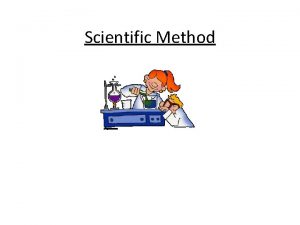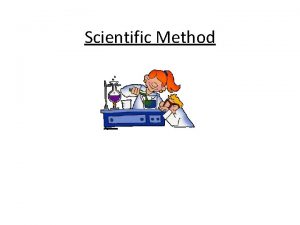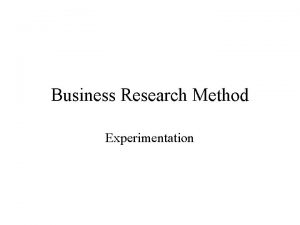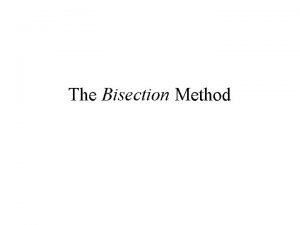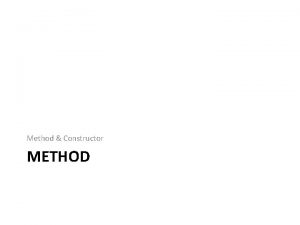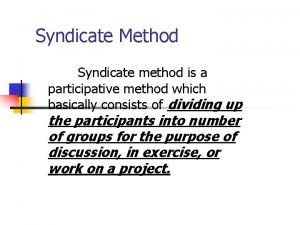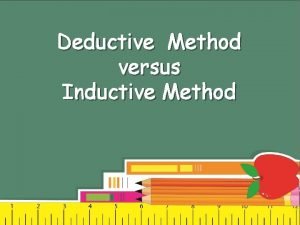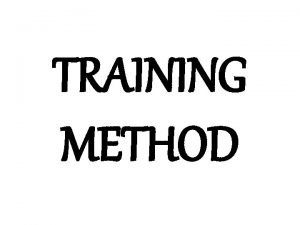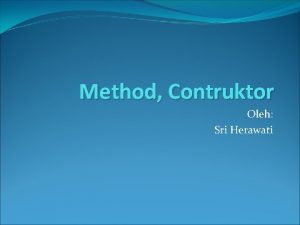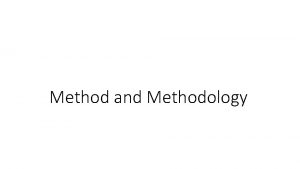Research Project Two Part Two The Method Section

























- Slides: 25

Research Project Two Part Two: The Method Section and other components The purpose of this presentation is to offer a more detailed explanation of the assignment than I offer in class.

Some Ground Rules Don’t just print these slides out indiscriminately—print to DISC if you must print them. Go through this as a teaching module—stop, when prompted, to discuss or write with your group when possible. Don’t assume that following these tips guarantees an “A. ” Save trees please

Some Guiding Metaphors Experienced cooks can look at a recipe and tell if the dish will taste good. Experienced architects and builders can look at a blueprint and tell if a building will be sound. This Research Project is a recipe or a blue print for a quantitative study. I will be able to tell if it is methodologically sound. You should be able to too!

What am I Looking For Critical Thinking: Is it clear from your Research Project that you understand the goals, limits and challenges of quantitative research (sampling, measurement, etc. ). Vocabulary: Can you express you ideas using the appropriate course vocabulary.

Review. . . Research Project Two will have five basic sections and an appendix: n n n Introduction that establishes context for and significance of your general RQ/problem. (heading or sub-headings here) Review of Literature that must include subheadings that demonstrategic organization Purpose of Study paragraph that provides a more specific research question now that we are educated by the review Method section that describes the methodology you would use to answer the RQ (more on this is in the other tutorial) References in strict adherence to APA style Appendix A: Your data collection instruments such as questionnaires or pretest/posttest.

@ this point. . I assume you’ve gone through the first tutorial on the literature review and that it makes sense This tutorial takes you through the remaining sections of the proposal: n n Method Conclusion References Appendices

An Example of an RQ RQ: Is regular playing of occulticthemed video games associated with greater belief in the supernatural? n What is likely approach? w Content Analysis w Survey w Pre/Quasi or Experimental Study? n Really guess before advancing slide. . .

My Answer Most likely approach is a pre/quasi experimental study n n n Post test only of pre-existing groups because you’ve got a group already playing the games and a group that doesn’t. You can only post test because they already play. If you said survey you were not far off, but quasi experiment is better because of our focus on cause and effect.

Did you notice. . . Notice that in that answer I demonstrate awareness of limitations (pre-existing groups, etc. ) and use specific vocabulary from our texts in labeling the approach. This is what I’m looking for from you as you think through sampling and measurement issues related to your study. COM 200 Connecting the dots is a big part of COM 200

Method Begin the method section by stating the method and offering a brief justification of the appropriateness of this method for addressing the RQ Cite source(s) to justify the choice. At a minimum our textbook would work. Even better is if other studies you come across call for a particular method.

Step by Step: Sample You will be needing a sample of people. Address such issues as n n n How many How chosen Any need for sub-sampling or stratifying the sample? At the end of this section your reader should have a good mental picture of who you are sampling and how you are selecting them. “Sweetie, I want us to participate in a study on how older couples argue, OK? ” “NO!, There! See, we argued!” “Sweetie, it’s for science!” “Fine, but I’m not missing the game!”

Step by Step: Instrument You need to create an entire data collection questionnaire for Appendix A (more later) You are strongly encouraged to use or adapt one or more existing instrument rather than develop most of your instrument yourself. In either case you would describe the instrument with several key examples of questions in the body. If you borrow from existing instruments cite them as you describe your own data collection tool. You are allowed to use more than existing questionnaire (or portions of it) in your study. You will almost certainly use more than one type of scale in your study.

For Example If I’m doing that video game study mentioned earlier I might argue that we would use a combination of Guttman and Likert type items. I might also mention that we borrowed an “Attitudes toward the occult” scale from a previous study in a psychology journal and cite the study. I would offer an illustrative example of items in the essay. In my discussion in the body of the essay I would refer the reader to Appendix A for more detail. Appendix A would have my entire questionnaire formatted exactly as I would hand it to participants (you are not limited to APA format).

Step By Step: Data Analysis The next subheading within the Method section is Data Analysis. Here is the core issue: Do you understand what statistics you need to make sense of your data once you collect it? You will need to understand a few things about your data to pick the right statistics and talk about them correctly.

Picking the Right Statistic What level of measurement are we using for the independent and dependent variables? n n n If you are measuring a variable at the nominal or ordinal level your statistical choices are very limited. Many times you will be measuring the independent variable at the nominal level and the dependent variable at the interval level. I have some links to statistics sources on this site that can help you choose. Our optional text is also very helpful here.

For Example In my study I have the IV (play/exposure) measured at the nominal level: no play, some play, lots of play and the DV (attitudes toward the occult) measured at the interval level using Guttman and Likert scales

Picking the Right Statistic The second issue is: What do we want to know? n n n Description Difference Correlation

OK, I was a bit tricky Remember EVERY study will focus at some point on description. You must summarize your data for your self and for your reader. Which descriptive statistics do you need to use to make sense of the data collected in this study?

Beyond Description. . . My research question deals primarily with difference: are the attitudes and beliefs of players different than those of non-players. n n So we know we’re measuring the DV at the interval level We know we are testing for significant difference between two groups What procedure should we use? Try to figure it out before advancing to the next slide!

Which Statistic? Significant difference using interval level DV? n n Chi Square T-Test ANOVA Pearsons Really guess before advancing slide

Which Statistic? Significant difference using interval level variable? n n Chi Square T-Test ANOVA Pearsons

Another Match Game Picking the right statistic is a lot like citing sources in APA. You have to figure what type of source it is and then match it to the APA guide. In picking the right statistic you must know the level of measurement for each variable and what you want to know. Then match that scenario to the appropriate statistic. Try THIS SITE.

Conclusion should address one or more of the following n n n Limitations of your study Likely results Follow up question to pursue after this study You must also address what you learned about social science by doing this project and use course vocabulary when doing so!

Some Hints Tie future questions back to literature review. Tie follow up studies to limitations of your own study Limit discussion of “what we learned” to genuine insights and not generic filler Use course vocabulary correctly Just kidding, they can be good or bad, like most anything else. . .

Final Thoughts Make sure APA is perfect at this point. Be sure tone of Research Project is formal, efficient writing that is similar to what you encountered in the journals. Have fun and be proud of your final product. If you’re not proud, revise it until you are.
 8-4 project part two: presentation
8-4 project part two: presentation Research methodology
Research methodology What is symposium method
What is symposium method Hát kết hợp bộ gõ cơ thể
Hát kết hợp bộ gõ cơ thể Ng-html
Ng-html Bổ thể
Bổ thể Tỉ lệ cơ thể trẻ em
Tỉ lệ cơ thể trẻ em Gấu đi như thế nào
Gấu đi như thế nào Thang điểm glasgow
Thang điểm glasgow Hát lên người ơi
Hát lên người ơi Môn thể thao bắt đầu bằng chữ đua
Môn thể thao bắt đầu bằng chữ đua Thế nào là hệ số cao nhất
Thế nào là hệ số cao nhất Các châu lục và đại dương trên thế giới
Các châu lục và đại dương trên thế giới Công thức tính thế năng
Công thức tính thế năng Trời xanh đây là của chúng ta thể thơ
Trời xanh đây là của chúng ta thể thơ Cách giải mật thư tọa độ
Cách giải mật thư tọa độ Làm thế nào để 102-1=99
Làm thế nào để 102-1=99 độ dài liên kết
độ dài liên kết Các châu lục và đại dương trên thế giới
Các châu lục và đại dương trên thế giới Thể thơ truyền thống
Thể thơ truyền thống Quá trình desamine hóa có thể tạo ra
Quá trình desamine hóa có thể tạo ra Một số thể thơ truyền thống
Một số thể thơ truyền thống Cái miệng xinh xinh thế chỉ nói điều hay thôi
Cái miệng xinh xinh thế chỉ nói điều hay thôi Vẽ hình chiếu vuông góc của vật thể sau
Vẽ hình chiếu vuông góc của vật thể sau Nguyên nhân của sự mỏi cơ sinh 8
Nguyên nhân của sự mỏi cơ sinh 8 đặc điểm cơ thể của người tối cổ
đặc điểm cơ thể của người tối cổ


























